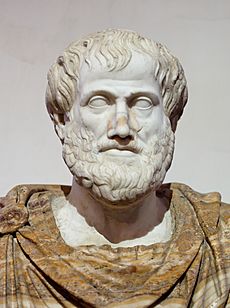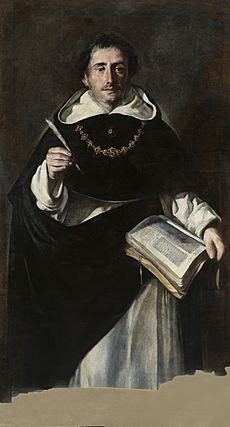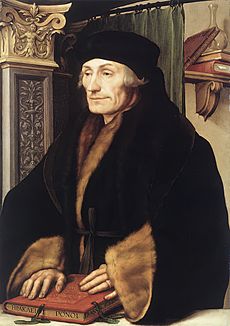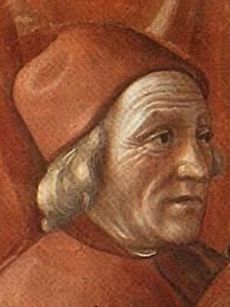Renaissance philosophy facts for kids
Renaissance philosophy refers to the ideas and ways of thinking that were popular in Europe between about 1400 and 1600. This time period is known as the Renaissance, which means "rebirth." It was a time when people rediscovered old ideas from ancient Greece and Rome.
This period of philosophy connects to medieval philosophy (earlier thinking, like that of Thomas Aquinas) and early modern philosophy (later thinking, starting with René Descartes around 1637).
Contents
What Stayed the Same?
Many parts of philosophy during the Renaissance were similar to how they were in earlier centuries.
How Philosophy Was Structured
After many writings by Aristotle were rediscovered in the 1100s and 1200s, people saw that philosophy could be divided into different areas. These included:
- Natural philosophy: Studying the natural world.
- Moral philosophy: Thinking about right and wrong, and how to live well.
- Metaphysics: Exploring big questions about reality and existence.
These areas became the main subjects taught in universities. People believed that the most "scientific" parts of philosophy were those that were more about ideas and could be applied widely. During the Renaissance, thinkers still saw these as the main areas. They also thought that logic (the study of correct reasoning) helped train the mind to understand the other three.
Where Ideas Came From
The sources for philosophical ideas also stayed similar. Aristotle was a very important thinker. His books were often used as a starting point for discussions, even if people didn't always agree with him. For example, in medieval times, students learned about physics by reading Aristotle's Physics. They studied ethics using his Nicomachean Ethics and politics using his Politics.
The idea that Aristotle's works were key to understanding philosophy continued in the Renaissance. Many new translations and explanations of his works appeared. Even after the Reformation, Aristotle's Nicomachean Ethics remained a main book for studying ethics in universities until the late 1600s.
In terms of how philosophy was studied, the scholastic method was still very popular. This method involved deep discussions and debates, often called "questions." Students would argue for or against different philosophical ideas. This helped them think quickly and use their knowledge of past philosophical traditions. Pico della Mirandola's Disputations (debates) were a good example of this continuing tradition.

Topics People Discussed
Because Aristotle's philosophy covered so many topics, medieval and Renaissance thinkers discussed a wide range of issues. Aristotle had written about things like how objects move, animal behavior, how we gain knowledge, and the idea of free will. He also explored how being good connects to happiness.
His ideas also led to discussions about topics important to Christians, such as whether the soul lives forever and if the world has always existed. All these topics continued to interest Renaissance thinkers. However, sometimes the answers they found were different because of changes in culture and religion.
What Changed?
Even though many things stayed the same, there were also important changes in philosophy during the Renaissance.
New Sources of Ideas
The Renaissance brought a much wider range of source materials. For example, in the Middle Ages, people knew very little about Plato. But in the 1400s, many of his works were translated into Latin. Marsilio Ficino's complete translation of Plato's works in 1484 was very important.
Petrarch, an early Renaissance thinker, greatly admired Plato, even though he couldn't read him directly. Petrarch also loved Roman poets like Virgil and Horace and the writer Cicero. He helped broaden what was considered important to read. Before this, pagan (non-Christian) poetry was often seen as dangerous.
By the 1500s, anyone who considered themselves educated read both Plato and Aristotle. They often tried to make their ideas fit together and with Christian beliefs. Donato Acciaiuoli's commentary on Aristotle's Ethics (published in 1478) was popular because it successfully blended these three traditions.
Other ancient philosophies also became popular again. While Epicureanism was often misunderstood, Pyrrhonism (a type of skepticism) and Academic Skepticism made a comeback through thinkers like Michel de Montaigne. Neostoicism, a new form of Stoicism, became popular thanks to Justus Lipsius. These ancient ideas were always looked at through a Christian lens.
Changes in Philosophy's Structure
While the basic Aristotelian structure of philosophy stayed mostly the same, some interesting changes happened within these areas. For example, in moral philosophy, Thomas Aquinas and his followers believed that politics was more important than ethics because it focused on the good of a larger group of people.

However, during the Renaissance, some thinkers disagreed. They argued that ethics (how individuals live) was the most important part of morality.
Other important figures, like Francesco Petrarca (Petrarch), questioned the idea that theoretical (idea-based) philosophy was the most important. He stressed the value of the practical side of ethics. Petrarch believed that philosophy should be guided by rhetoric (the art of persuasive speaking). For him, the goal of philosophy wasn't just to find the truth, but to encourage people to do good. This idea, common in Italian humanism, sometimes led to focusing almost all philosophy on ethics.
How Philosophy Was Studied
Even though scholasticism continued to be strong, Italian humanists (people who loved and practiced the humanities) challenged its dominance. They believed philosophy could be linked with rhetoric. They also thought that scholarly writing needed to return to the elegant and precise style of classical authors.
So, they tried to make philosophy more appealing. In 1416–1417, Leonardo Bruni, a leading humanist and chancellor of Florence, re-translated Aristotle's Ethics. He used a more flowing and natural Latin, hoping to show the beauty of Aristotle's Greek and make the text easier for people without a deep philosophical background to understand. Others tried to please humanists by adding interesting historical examples or poetry quotes to their commentaries, or by avoiding the standard scholastic debate format.

The main idea was to free philosophy from its technical language so more people could read it. Many summaries, simpler versions, and dialogues about philosophical topics were created to spread these ideas more widely. Humanists also encouraged studying Aristotle and other ancient writers in their original languages. Desiderius Erasmus, a great Dutch humanist, even prepared a Greek edition of Aristotle's works. Eventually, university professors had to at least pretend they knew Greek!
At first, humanists weren't big fans of translating philosophy into everyday languages like Italian. But once Italian was seen as a language suitable for serious discussions, many efforts began, especially from the 1540s onwards. Alessandro Piccolomini even planned to translate or simplify all of Aristotle's works into Italian. Other important figures like Benedetto Varchi and Giambattista Gelli were also active in Florence, working on presenting Plato's ideas in Italian. This rise of philosophy in everyday languages is a new area of research.
New Topics and Focuses
It's hard to make general statements about how philosophical topics changed in the Renaissance because we don't yet have a complete picture of the period. We know that debates about the freedom of the will continued, for example, in the famous arguments between Erasmus and Martin Luther. Spanish thinkers became very interested in the idea of nobility, and dueling became a topic of much discussion (was it allowed or not?).
Earlier historians sometimes focused too much on thinkers like Pietro Pomponazzi and his ideas about the immortality of the soul, or on Pico della Mirandola's Oration on the Dignity of Man. Some thought these showed a growing lack of religion or even atheism. However, most philosophers of the time were religious Christians. The 1500s saw both the Protestant and Catholic reformations, and the Renaissance period ended with the Thirty Years' War (1618–1648), a major religious conflict. This shows that religion was incredibly important during this time, and you can't study philosophy from this period without remembering that.

This is true for the philosophy of Marsilio Ficino (1433–1499). He reinterpreted Plato's ideas by looking at early Greek thinkers and also through the lens of Christianity. Ficino hoped that a "purified" philosophy would lead to a religious renewal in his society. For example, he changed the idea of homosexual love in Plato's Symposium into "spiritual love" (known as Platonic love). Later, others like Pietro Bembo and Baldassare Castiglione applied this idea to relationships between men and women.
Ficino and his followers were also interested in "hidden knowledge." This was because he believed that all ancient knowledge was connected and came from God's plan. For instance, he thought Moses received his wisdom from the Greeks, who got it from others, all fitting together perfectly. This idea is related to Hermeticism. While Ficino's interest in astrology was common then, it was usually seen as separate from philosophy.
In conclusion, Renaissance philosophy was not entirely new, nor did it simply repeat old ideas. Historians call this period the "Renaissance" because it saw a "rebirth" of ancient ways of thinking, sources, and attitudes toward literature and art. However, every time old ideas are brought back, they are shaped by current concerns and beliefs. The Renaissance was no different: old ideas mixed with and changed by new ones. While it wasn't a completely revolutionary start in philosophy, the blend of Christianity, Aristotelianism, and Platonism that was common before was re-examined. This led to new ways of thinking, using more complete and varied sources, often in their original languages, and connecting to new social and religious realities for a much wider audience.
Renaissance Philosophers
- Coluccio Salutati (1331–1406)
- Gemistus Pletho (1355–1452)
- Leonardo Bruni (1370–1444)
- Nicholas of Cusa (1401–1464)
- Leon Battista Alberti (1404–1472)
- Lorenzo Valla (1407–1457)
- Marsilio Ficino (1433–1499)
- Pietro Pomponazzi (1462–1524)
- Giovanni Pico della Mirandola (1463–1494)
- Erasmus of Rotterdam (1466–1536)
- Niccolò Machiavelli (1469–1527)
- Nicolaus Copernicus (1473–1543)
- Thomas More (1478–1535)
- Charles de Bovelles (1479–1553)
- Francesco Guicciardini (1483–1540)
- Martin Luther (1483–1546)
- Bernardino Telesio (1509–1588)
- Jean Bodin (1529–1596)
- Michel de Montaigne (1533–1592)
- Tycho Brahe (1546–1601)
- Joest Lips (1547-1606)
- Giordano Bruno (1548–1600)
- Francisco Suárez (1548–1617)
- Francis Bacon (1561–1626)
- Galileo Galilei (1564–1642)
- Tommaso Campanella (1568–1639)
- Johannes Kepler (1571–1630)
- Giulio Cesare Vanini (1585–1619)
See also
 In Spanish: Filosofía renacentista para niños
In Spanish: Filosofía renacentista para niños
- Age of Enlightenment
- Hermeticism
- Renaissance humanism
- Renaissance magic
- Platonism in the Renaissance
- School of Salamanca

